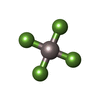+Search query
-Structure paper
| Title | Specific protonation of acidic residues confers K selectivity to the gastric proton pump. |
|---|---|
| Journal, issue, pages | J Biol Chem, Vol. 300, Issue 1, Page 105542, Year 2024 |
| Publish date | Dec 10, 2023 |
 Authors Authors | Hridya Valia Madapally / Kazuhiro Abe / Vikas Dubey / Himanshu Khandelia /   |
| PubMed Abstract | The gastric proton pump (H,K-ATPase) transports a proton into the stomach lumen for every K ion exchanged in the opposite direction. In the lumen-facing state of the pump (E2), the pump selectively ...The gastric proton pump (H,K-ATPase) transports a proton into the stomach lumen for every K ion exchanged in the opposite direction. In the lumen-facing state of the pump (E2), the pump selectively binds K despite the presence of a 10-fold higher concentration of Na. The molecular basis for the ion selectivity of the pump is unknown. Using molecular dynamics simulations, free energy calculations, and Na and K-dependent ATPase activity assays, we demonstrate that the K selectivity of the pump depends upon the simultaneous protonation of the acidic residues E343 and E795 in the ion-binding site. We also show that when E936 is protonated, the pump becomes Na sensitive. The protonation-mimetic mutant E936Q exhibits weak Na-activated ATPase activity. A 2.5-Å resolution cryo-EM structure of the E936Q mutant in the K-occluded E2-Pi form shows, however, no significant structural difference compared with wildtype except less-than-ideal coordination of K in the mutant. The selectivity toward a specific ion correlates with a more rigid and less fluctuating ion-binding site. Despite being exposed to a pH of 1, the fundamental principle driving the K ion selectivity of H,K-ATPase is similar to that of Na,K-ATPase: the ionization states of the acidic residues in the ion-binding sites determine ion selectivity. Unlike the Na,K-ATPase, however, protonation of an ion-binding glutamate residue (E936) confers Na sensitivity. |
 External links External links |  J Biol Chem / J Biol Chem /  PubMed:38072058 / PubMed:38072058 /  PubMed Central PubMed Central |
| Methods | EM (single particle) |
| Resolution | 2.51 Å |
| Structure data | EMDB-37391, PDB-8wa5: |
| Chemicals |  ChemComp-K:  ChemComp-ALF:  ChemComp-MG:  ChemComp-CLR:  ChemComp-PCW:  ChemComp-NAG:  ChemComp-HOH: |
| Source |
|
 Keywords Keywords |  MEMBRANE PROTEIN / MEMBRANE PROTEIN /  P-type ATPase / gastric proton pump / primary transporter / P-type ATPase / gastric proton pump / primary transporter /  transporter transporter |
 Movie
Movie Controller
Controller Structure viewers
Structure viewers About Yorodumi Papers
About Yorodumi Papers






